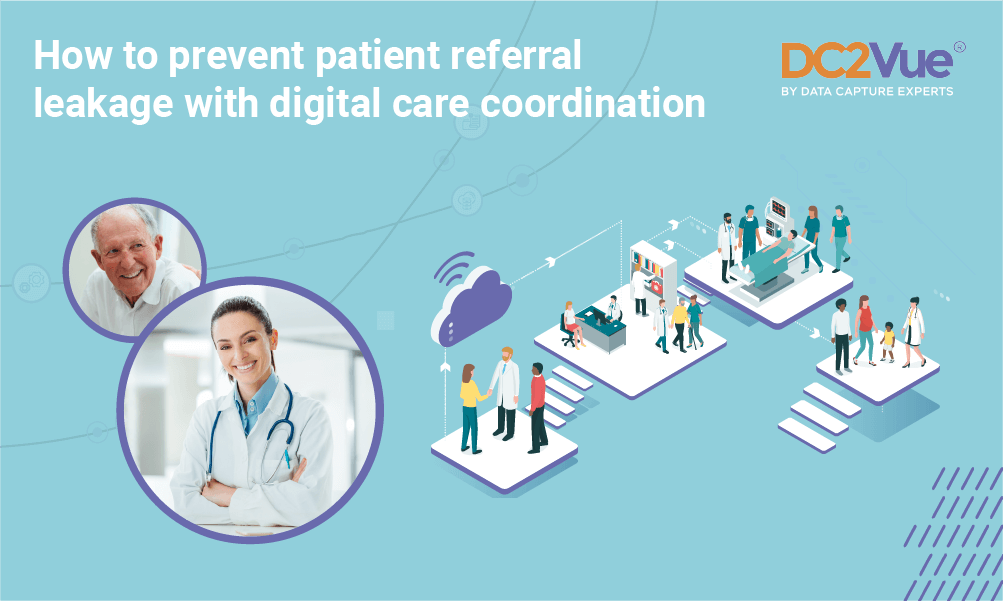Coordinating patient care so that they remain in-network is challenging. Physicians don’t always have a comprehensive system overview when they make a referral, causing some patients to go elsewhere. Consequently, networks lose revenue. Therefore, preventing patient referral leakage with digital care coordination is a priority for many healthcare providers. Operators must understand why and where the leakage occurs if they want to stop it.
What Is Network Referral Leakage?
Referral leakage occurs when patients leave the hospital’s network and seek medical care from out-of-network providers. For instance, a patient could receive a laparoscopic procedure from the hospital and then go to a physical therapist from another network post-operation.
The Benefits Of Addressing Patient Referral Leakage
The benefits of addressing referral leakage are substantial.
First, patients receive a more streamlined experience. Same-network healthcare providers are more likely to provide a consistent level of care. Policies shouldn’t change from one practitioner to another. Moreover, they are more likely to communicate effectively with each other. In-network operators often share clinical records seamlessly, providing a personalised experience.
Second, healthcare providers benefit. Keeping patient volumes high and within network drives higher service utilisation and economies of scale. Unfortunately, 60 percent of health systems don’t have plans to prevent patient leakage. This statistic represents a significant lost opportunity.
What Are The Barriers To Reducing Patient Referral Leakage?
Resolving patient referral leakage is an intractable problem for many hospital networks. That’s because multiple factors are driving it. These include:
Competition from other health networks. Patients may choose to use different systems based on price and convenience.
Lack of staff talent. Hospitals may not have the personnel they require to offer patients a comprehensive service
Lack of appropriate facilities at the hospital. Hospital networks may be unable to provide the care services the patient needs.
Lack of resources. Budget limitations may prevent hospitals from implementing care services that keep patients in-house.
Failure to measure the scale of leakage. Some hospitals do not know the scope of the leakage because they don’t collect statistics. Failing to understand the depth of the problem blunts the response.
Lack of effective management. Hospital systems that don’t put anyone in overall control of their patient referral leakage situation can struggle to mount an effective response.
Ineffective physician support. Individual doctors may disagree with an in-network policy and continue to refer their patients to out-of-network providers or their personal friends.
Ineffective technology. Most providers aren’t using advanced collaborative systems to bring their teams together, relying instead on outmoded practices.
Data silos. Hospitals can collect all the necessary information but fail to share it effectively with all their stakeholders. Walls around data prevent progress.
Lack of executive support. Though rare, hospital C-suites can fail to get behind initiatives to reduce patient referrals.
Reducing patient referrals is also a low priority in many institutions. Hospital networks may not see the urgency if they can’t see how much money they are losing. These situations require careful data collection and concrete numbers to establish the extent of the problem.
Reducing Network Referral Leakage
Reducing network referral leakage requires a system-level intervention. Hospitals, home care providers, and specialist clinics must communicate effectively. Networks must build efficient information exchange systems to liaise effectively internally and externally with relevant providers.
Once networks implement these systems, they have a higher-level overview of the patient journey. They can see exactly how they are moving through the system and collaborate effectively with other providers. In doing so, they can provide a continuum of care, linking all parties to enhance the patient experience.
For example, a hospital operating an anti-network referral leakage scheme can link up patients’ services. Transplant patients can benefit from transportation and post-operative care facilities and providers. Each link in the network would understand patients’ needs and respond accordingly, offering a patient-centred approach.
Patient network leakage remains a significant issue. Two-thirds of specialty centre referrals arrive outside a health system’s emergency department. However, some networks are finding ways to solve the problem.
A leading approach is to educate and align providers. Hospital networks are doing this by creating outreach programs. These seek to address the issues responsible for patient leakage systemically.
They are also adding capacity to their facilities. Enhanced ability to provide patient care in-house in a proximate location increases the likelihood of within-network treatment. Patients can often walk down a hallway or corridor to another room to receive the care they need instead of going off-site.
A holistic view of the health system’s operating structure improves clinical and operational decision-making. Stakeholders can take steps to ensure patients remain within the revenue-generating apparatus of the institution.
Linking a connected network of care via digital systems also makes it possible to operate as a real-time health system without excessive administrative burden. Only this strategy can empower organisations to reduce referral leakage from their networks.
Adopting a patient-centred approach improves patient outcomes and makes healthcare organisations more resilient. It also enhances the patient journey, both medically and from a customer care perspective.
How DC2Vue Can Help Reduce Patient Referral Leakage
DC2Vue is a data-driven patient referral management system designed to enhance the continuity and coordination of care. The software integrates patient records across all services and enables effective clinical and administrative workflows. Improved communication between multidisciplinary teams reduces the risk of patients going out-of-network.
For instance, DC2Vue implements a one-patient, one-view timeline. This feature lets you efficiently manage all incoming and outgoing referrals. You can also meet patients’ needs more comprehensively with the all-in-one workforce management tool. This facility offers better control and visibility over your team’s schedules. You can roster more effectively, ensuring patients can see practitioners at the most convenient time.
Lastly, you can improve patient engagement through various communication portals, reducing the temptation to go out-of-network. Individuals can engage doctors from anywhere, with any device.
Contact our team for more information on DC2Vue and how it can reduce patient referral leakage.



